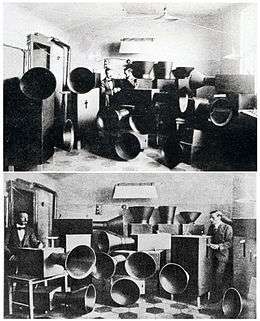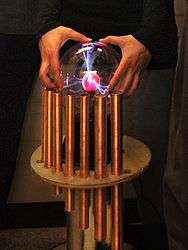Experimental musical instrument

An experimental musical instrument (or custom-made instrument) was an a musical instrument that modifies or extends an existing instrument or class of instruments, or defines or creates a new class of instrument. Some are created through simple modifications, such as cracked drum cymbals or metal objects inserted between piano strings in a prepared piano. Some experimental instruments are created from household items like a homemade mute for brass instruments such as bathtub plugs. Other experimental instruments are created from electronic spare parts, or by mixing acoustic instruments with electric components.
The instruments created by the earliest 20th-century builders of experimental musical instruments, such as Luigi Russolo (1885–1947), Harry Partch (1901–1974), and John Cage (1912–1992), were not well received by the public at the time of their invention. Even mid-20th century builders such as Ivor Darreg, Pierre Schaeffer and Pierre Henry did not gain a great deal of popularity. However, by the 1980s and 1990s, experimental musical instruments gained a wider audience when they were used by bands such as Einstürzende Neubauten and Neptune.
Types

Experimental musical instruments are made from a wide variety of materials, using a range of different sound-production techniques. Some of the simplest instruments are percussion instruments made from scrap metal, like those created by German band Einstürzende Neubauten. Some experimental hydraulophones have been made using sewer pipes and plumbing fittings.[1]
Since the late 1960s, many experimental musical instruments have incorporated electric or electronic components, such as Fifty Foot Hose 1967-era homemade synthesizers, Wolfgang Flür and Florian Schneider's playable electronic percussion pads, and Future Man's homemade drum machine made out of spare parts and his electronic Synthaxe Drumitar.
Some experimental musical instruments are created by luthiers, who are trained in the construction of string instruments. Some custom made string instruments are employed with three bridges,[2] instead of the usual two (counting the nut as a bridge). By adding a third bridge, one can create a number of unusual sounds reminiscent of chimes, bells or harps[3][4][5][6] A 'third bridge instrument' can be a "prepared guitar" modified with an object – for instance, a screwdriver – placed under the strings to act as a makeshift bridge, or it can be a custom made instrument.
One of the first guitarists who began building instruments with an extra bridge was Fred Frith. Guitarist and composer Glenn Branca has created similar instruments which he calls harmonic guitars or mallet guitars. Since the 1970s, German guitarist and luthier Hans Reichel has created guitars with third-bridge-like qualities.
Modern Day electronic low voltage experimental musical instruments, can be found at Bentmonkeycage in California USA. These glitched instruments are used in Movie Soundtracks, Live DUBNOISE performances, DJ performances, and Recording. The electronic unengineered circuitry within the device, can be manipulated with simple body contacts, light sensitive photocells, infrared signals, and radio waves (as in a theremin).
History
1900–1950s

Luigi Russolo (1885–1947) was an Italian Futurist painter and composer, and the author of the manifestoes The Art of Noises (1913) and Musica Futurista. Russolo invented and built instruments including intonarumori ("intoners" or "noise machines"), to create "noises" for performance. Unfortunately, none of his original intonarumori survived World War II. Replicas are being made though.
Léon Theremin was a Russian inventor, most famous for his invention of the theremin around 1919–1920, one of the first electronic musical instruments. The Ondes Martenot is another early example of an electronic musical instrument.
The luthéal is a type of prepared piano created by George Cloetens in the late 1890s and used by Maurice Ravel in his Tzigane for luthéal and violin. The instrument can produce sounds like a guitar or a harmonica, with strange tick-tocking sounds. It had several tone-colour (not exclusively "pitch") registers that could be engaged by pulling stops above the keyboard. One of these registers had a cimbalom-like sound, which fitted well with the gypsy-esque idea of the composition.

Harry Partch (1901–1974) was an American composer and instrument builder. He was one of the first twentieth-century composers to work extensively and systematically with microtonal scales, writing much of his music for custom-made instruments he built himself, tuned in 11-limit just intonation. His adapted instruments include the adapted viola, three adapted guitars, and a 10-string fretless guitar. As well, he retuned the reeds of several reed organs and designed and built many instruments from raw materials, including the Diamond Marimba, Cloud Chamber Bowls, the Spoils of War, and a Gourd Tree.

John Cage (1912–1992) was an American composer who pioneered the fields of chance music, electronic music and unorthodox use of musical instruments. Cage's prepared piano pieces used a piano with its sound altered by placing various objects in the strings). Ivor Darreg (1917–1994) was a leading proponent of and composer of microtonal or "xenharmonic" music. He also created a series of experimental musical instruments. In the 1940s, Darreg built an amplified cello, amplified clavichord and an electric keyboard drum.
1950s–1960s
Throughout the 1960s the Canadian musician Bruce Haack created many electronic experimental musical instruments, including the famous Dermatron, which was played by touching people's faces. His influence is still recognized by many artist (For instance The Beastie Boys). Kraftwerk is known for their self built synthesizers in the early 70s.

In the 1960s, Michel Waisvisz and Geert Hamelberg developed the Kraakdoos (or Cracklebox), a custom made battery-powered noise-making electronic device. It is a small box with six metal contacts on top, which when pressed by fingers will generate a range of unusual sounds and tones. The human body becomes a part of the circuit and determines the range of sounds possible; different people will generate different sounds.
1970s–1980s

The neola is a stringed musical instrument invented in 1970 by Goronwy Bradley Davies, Llanbedr, Wales. Plastics and aluminium were used in the design and the invention was recognized in a British Patent (registered 16 August 1972) and a Design Council award. The name "neola" was registered for the instrument.[7][8] The invention is intended as a tenor, replacing an instrument in the viol family that has been surpassed by the more recent violin family. The strings are tuned to G, D, A, and E, an octave below the violin, and the instrument may be performed similar to a violoncello. ‘Cello players would need to adapt their technique to accommodate the shorter string and body length, and use of the thumb position would not be the same. The design specifications are well suited to industrial manufacture, retaining consistency in quality. This is not the case with traditional instruments since the choice of fine materials and the skills of the luthier are essential in producing instruments with superior sound qualities.
In the mid-1970s, Allan Gittler (1928–2003) made an experimental custom-made instrument called the Gittler guitar. The Gittler guitar has 6 strings, each string has its own pickup. The later versions have a plastic body. The steel frets give the instrument a sitar-like feel. Six individual pick ups can be routed to divided outputs.
Z'EV and Einstürzende Neubauten made several percussion instruments out of trash. No Wave artist Glenn Branca began building 3rd bridge zithers with an additional movable bridge positioned on the just intoned knotted positions of the harmonic series. Hans Reichel (Born 1949) is a German improvisational guitarist, luthier, and inventor. Reichel has constructed and built several variations of guitars and basses, most of them featuring multiple fretboards and unique positioning of pickups as well as the same indirect playing technique as Branca's instruments. The resulting sounds exceed the range of conventional tuning and add interesting effects, from odd overtones to metallic noises. Later he invented his Daxophone, where he's most famous for. His Daxophone consists of a single wooden blade fixed in a block containing a contact microphone. Normally, it is played by bowing the free end, but it can also be struck or plucked, which propagates sound in the same way a ruler halfway off a table does. These vibrations then continue to the wooden-block bass, which in turn is amplified by the contact microphone(s) therein. A wide range of voice-like timbres can be produced, depending on the shape of the instrument, the type of wood, where it is bowed, and where along its length it is stopped with a separate block of wood (fretted on one side) called the "dax."
American composer Ellen Fullman (born in 1957) developed the long string instrument in the early 1980s, which is tuned in just intonation and played by walking along the length the long strings and rubbing them with rosined hands and producing longitudinal vibrations.
Bradford Reed invented the pencilina, a custom-made string instrument in the 1980s. It is a double-neck 3rd bridge guitar that is similar in construction to two long, thin zithers connected by a stand. Wedged over and under the strings in each neck is an adjustable rod, a wooden drum stick for the guitar strings and a metal rod for the bass strings. In addition, there are four bells. The pencilina is played by striking its strings and bells with sticks. The strings may also be plucked or bowed.
Uakti (WAHK-chee) is a Brazilian instrumental musical group active in the 1980s known for using custom-made instruments built by the group. Marco Antônio constructed various instruments in his basement out of PVC pipe, wood, and metal.
Remo Saraceni made a number of Synthesizer type instruments with unusual interfaces, his most famous being The Walking piano made famous in the film Big.
In the 1980s, the folgerphone was developed. It is a wind instrument (or aerophone), classifiable as a woodwind rather than brass instrument despite being made of metal, because it has a reed (cf. saxophone). It is made from an alto sax mouthpiece, with copper tubing and a coffee can. Although it uses sax parts, it is a cylindrical bore instrument, and thus part of the clarinet family.
In India, the new instrument based on harmonium style was developed by Pt. Manohar Chimote with the combination of keys and sympathetic strings to create the tone most suitable for playing the instrument for solo playing. This was named as "Samvadini". It is based on just intonation tuning system and played in one key. It is exclusive solo instrument with great potentials. His follower Jitendra Gore now plays this solo instrument.
1990s and 2000s

The bazantar is a five-string double bass with 29 sympathetic and 4 drone strings and has a melodic range of five octaves invented by musician Mark Deutsch, who worked on the design between 1993 and 1997 (US 5883318 issued March 16, 1999). It is designed as a separate housing for sympathetic strings (to deal with the increased string tension) mountable on a double bass or cello, modified to hold drone strings.
Ken Butler makes odd-shaped, guitar-like instruments made out of trash, rifles and other material. He also builds violins in eccentric shapes.
Iner Souster (born in 1971) is a builder of experimental musical instruments, visual artist, musician, fauxbot designer and film maker who lives in Toronto, Ontario, Canada. Souster builds most of his instruments from trash, found, and salvaged materials. Some of his instruments are one string string instruments or thumb pianos. One of his more complicated instruments is the "Bowafridgeaphone" (bow a fridge a phone). Leila Bela is an Iranian-born American avant-garde musician and record producer from Austin, Texas. The Japanese multi-instrumentalist and experimental musical instrument builder Yuichi Onoue developed a two string hurdy-gurdy like fretless violin, called the Kaisatsuko, as well as a deeply scaloped electric guitar for microtonal playing techniques.[9]
Solmania from Japan and Neptune are noise music bands that built their own custom made guitars and basses. Solmania modifies their instruments with extra droning string and Neptune built guitars out of scrap metal and make electric lamellophones. The bass is built using a VCR casing and another one of their instruments has a jagged scythe at the end of it. They also play on custom made percussion instruments and electric lamellophones. Neptune began in 1994 as a student art project by sculptor/musician Jason Sanford. In 2006 Neptune signed with Table of the Elements, an experimental record label that also has performers such as Rhys Chatham, John Cale, Captain Beefheart on its roster.
The Blue Man Group also experimented with home-made percussive instruments, made from PVC pipes and other materials. A specially-constructed studio was needed for the recording of their first album.
In the 2000s, Canadian luthier Linda Manzer created the Pikasso guitar, a 42-string guitar with three necks. It was popularized by jazz guitarist Pat Metheny, who used it on the song "Into the Dream" and on several albums. Its name is ostensibly derived from its likeness in appearance to the cubist works of Pablo Picasso. In 2003 the Tritare was created by Samuel Gaudet and Claude Gauthier in Canada. Experimental luthier Yuri Landman built a variety of electric string resonance tailed bridge and 3rd bridge guitars like the Moodswinger, Moonlander and the Springtime for indie rock and noise rock acts like Sonic Youth, Liars, Blood Red Shoes as well as electric thumb pianos and electric drum guitars and spring drum instruments.

In 2005, architect Nikola Bašić built a Sea organ in Zadar, Croatia, which is an experimental musical instrument which plays music by way of sea waves and tubes located underneath a set of large marble steps. Concealed under these steps is a system of polyethylene tubes and a resonating cavity that turns the site into a huge musical instrument, played by the wind and the sea. The waves create somewhat random but harmonic sounds.
In 2010, composer Alexis Kirke and technologist Tim Hodgson turned the University of Plymouth's Roland Levinsky Building into a form of musical instrument to be played by the rising sun, as part of Peninsula Arts Contemporary Music Festival. Light sensors were placed across seven floors of the building and fed by radio network into a computer music instrument analogous to a Mellotron. As the sun rose the "Sunlight Symphony" played in the reverberant space of the Roland Levinsky Building's open plan foyer.
For her 2011 album Biophilia, Icelandic artist Bjork developed an instrument based on a Tesla Coil and a second instrument described as a cross between a Gamelan and a Celesta, dubbed the "Gameleste."
In 2013, a research team of McGill University came up with digital musical instruments made in the form of Prosthesis.
Builders not mentioned in the text
Artists

- Cabo San Roque
- Pierre Bastien
- Bruce Haack
- That 1 Guy
- Fifty Foot Hose
- Einstürzende Neubauten
- Fred Frith
- Micachu
- The Music Tapes
- Neptune
- Les Luthiers
- Senyawa
- Sleepytime Gorilla Museum
- Thomas Truax
- Uakti
- Futureman
- Herbie Hancock
- Ken Butler
See also
Publications
- Experimental Musical Instruments (EMI) was a periodical published by Bart Hopkin, a leader in 20th-century experimental music design and construction. Though no longer in print, back issues are still available.
- Proceedings of the International Computer Music Conference (ICMC)
- Proceedings of the New Interfaces for Musical Expression (NIME) conference
References
- ↑ Hydraulophones, Amazing Woodwater Instruments Collection
- ↑ Moodswinger - Experimental electric zither musical instrument, unique and unusual
- ↑ "PREPARATION MATERIALS" (PDF). 7 September 2013. Retrieved 2014-08-08.
- ↑ Prepared Guitar Techniques - Matthew Elgart/Peter Yates (Elgart/Yates Guitar Duo) ISBN 0-939297-88-4, California Guitar Archives, 1990
- ↑ "About the pencilina". pencilina.com. Retrieved 2014-08-08.
- ↑ freesound :: view tag :: prepared-guitar
- ↑ "Stringed Musical Instrument". lens.org. 1972. Retrieved 2014-08-08.
- ↑ stringed musical instruments
- ↑ Yuichi Onoue's Kaisatsuko on hypercustom.com
Further reading
- Applebaum, Mark. “Progress Report: The State of the Art after Sixteen Years of Designing and Playing Electroacoustic Sound-Sculptures.” eContact! 12.3 – Instrument—Interface (June 2010). Montréal: CEC.
- Leonardson, Eric. “The Springboard: The Joy of Piezo Disk Pickups for Amplified Coil Springs.” eContact! 10.3 – Symposium Électroacoustique de Toronto 2007 Toronto Electroacoustic Symposium (May 2008). Montréal: CEC.
External links
| Wikimedia Commons has media related to Experimental musical instruments. |
- oddmusic, a website dedicated to unique, odd, ethnic, experimental and unusual musical instruments and resources.
- Noisejunk, an extensive list of experimental musical instrument links
- EMI
- NIME community page
- www.siegelproductions.ca, a picture gallery of unusual instruments
- Table of contents of articles on Psychevanhetvolk about experimental instruments]
- Plastic Sound, an exhibit of musical instruments made of PVC pipe
| ||||||||||||||||||||||||||||||||||||||
| ||||||||||||||||||||||
| ||||||||||||||||||||||||||||||||||||||||||
